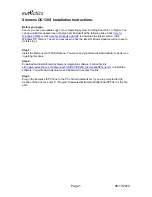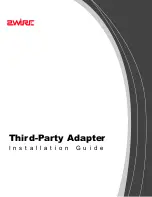
36
Note that
Power blades support only Virtual SCSI (VSCSI) disk virtualization through
FCoCEE
. N_Port ID Virtualization (NPIV) via FCoCEE is not currently supported. 10GbE
network connectivity for Power blades is supported.
FCoCEE is not supported in BladeCenter
S for any blade servers, including Power blades
.
4.11.1. Requirements for FCoCEE
The following minimum hardware and software requirements must be met in order to use
FCoCEE for IBM i on Power blades:
•
IBM BladeCenter JS12, JS22, JS23, JS43, PS700, PS701 or PS702
•
One QLogic 2-port 10 Gb Converged Network Adapter (CFFh) for IBM BladeCenter per
blade
•
One 10Gb Ethernet Passthrough Module for IBM BladeCenter (P/N 46M6181)
•
One supported TOR FCoCEE switch. Currently the Brocade 8000 is the only supported
switch, and it is also offered as the IBM Converged Switch B32, machine type and model
3758-B32
•
Service processor firmware 350_xxx from October 2009 or later
•
VIOS 2.1.2 or later
•
IBM i 6.1.1 or later
Note that the QLogic CNA can also be used solely as a 10GbE expansion adapter with no FC
frames encapsulated in the 10GbE traffic. In that case, the CNA can connect to the 10Gb
Ethernet Passthrough Module for IBM BladeCenter (P/N 46M6181) in I/O bay 7 or 9 and then to
an external Ethernet switch; or to the BNT Virtual Fabric 10Gb Switch Module for IBM
BladeCenter (P/N 46C7191) in I/O bay 7 or 9.
4.11.2. Implementing FCoCEE
Configuration of virtual disk and networking for IBM i on blade via FCoCEE is similar to that for
regular Fibre Channel-attached storage and Ethernet network adapters. As described above, the
TOR FCoCEE switch provides standard 8Gb FC connectivity to supported storage subsystems.
The host ports used on the external storage and the 10GbE ports on the QLogic CNA must be in
the same zone, which is created on the TOR switch. The storage subsystem is then configured
by creating AIX/VIOS LUNs and mapping them to the WWPNs on the CNA. To locate the
WWPNs on the CNA, follow the same steps as for any other blade FC expansion adapter:
•
Open a browser session to the AMM and sign on with an administrator userid
•
Click
Hardware VPD
•
Locate the correct blade by slot number and click the high-speed expansion card
designated
Ethernet HSEC
•
Click
Ports
•
The CNA’s WWPNs are displayed under
High Speed Expansion Card Unique IDs
,
whereas its MAC addresses are displayed under
High Speed Expansion Card MAC
Addresses
Once the LUNs from the storage subsystem are available in VIOS, they are assigned to an IBM i
LPAR using IVM. IBM recommends using the best-practice FC storage settings in VIOS
described in section 4.2. The 10GbE FCoCEE ports on the CNA report in VIOS as both two fcsX
(FC port) and two entX (Ethernet port) devices, similar to the following:
fcs0 Available 10Gb FCoE PCIe Blade Expansion Card (7710018077107f01)
fcs1 Available 10Gb FCoE PCIe Blade Expansion Card (7710018077107f01)
ent2 Available 10 Gb Ethernet PCI Express Dual Port Adapter (7710008077108001)
ent3 Available 10 Gb Ethernet PCI Express Dual Port Adapter (7710008077108001)
















































